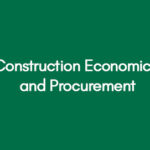![Mediation-in-Qatar-[Questionnaire]](https://premierdissertations.com/wp-content/uploads/2020/12/Mediation-in-Qatar-Questionnaire-1.jpg)
Questionnaire Survey for Mediation in Qatar
December 19, 2020
Construction Economics and Procurement
December 19, 2020Chapter I- Research Context and Introduction
The study aims to explore how BIM can be effectively employed in infrastructure projects, identifying the challenges and benefits associated with its implementation. Analyze the study's background and setting below.
Background
Enhancement in technology has created fundamental changes in the designs and infrastructure of the global construction sector. Enforcement of Building Information Modelling (BIM) is considered one of the transformational changes in the construction industry that transform the collaboration of stakeholders of a project to new limits. BIM stands for the digital demonstration of the functional, model, and physical characteristics of any construction project (Ameh and Osegbo 2011). Also, BIM is a shared resource of knowledge among stakeholders of a project to provide comprehensive information for decisions related to infrastructure, designs, durability, material choices, and sustainable aspects of the project.
Explore Additional Background Information about the BIM Study Here
According to Oyewobi et al. (2011), BIM-based project modelling in 3-D and 4-D has enhanced planning and project scheduling and considerably improved the planner's and designers’ perceptions. The research in this area explored the increasing adoption of BIM technology in the construction industries of the UK (Khosrowshahi and Arayici 2012), US (Becerik-Gerber and Samara 2010), and other developed countries. This technology facilitated strong database modelling, project visualisation in 4D and more capabilities of simulation and analysis. Also, with the rapid increase in the concerns of global warming and greenhouse impacts, the trend of designing and implementing the infrastructure of sustainable construction has increased in recent years (Wong and Fan, 2013; Liua et al., 2015). An important aspect of BIM is to facilitate sustainable building designs to optimise the designing of sustainable buildings.
This section asserted the research context, background, aim and objectives, research question, and literature review of the dissertation.
Purpose of the Research
There are major concerns found in the performance of the global construction industry related to lack of productivity and inefficiency apart from the project deliveries in fragments (Abubakar et al. 2014; Ameh and Osegbo, 2011). Therefore, the industry needs a mindset in setting the standards of performance and efficiency in delivering sustainable projects (Succar et al., 2013). The important factors of consideration are infrastructure, quality, value, design attributes, cost-effectiveness, and effective collaboration of all stakeholders of particular construction projects (Nederveen et al. 2011). Building Information Modelling (BIM) is one of the several initiatives adopted by the global construction sector in recent decades to address these significant factors. The rapid popularity of this collaboration framework that has evolutionarily transformed the technology of construction infrastructure, quality, and designs has encouraged developed economies to utilise BIM on a mass scale.
Find out the Importance of BIM in the Construction Industry Here
However, Barati et al. (2013) asserted that BIM has the potential not only for developed economies, but its awareness is important in the construction industry of developing countries also. There is very little research found on the application of BIM in Middle Eastern countries. Infrastructure and designing of sustainable buildings is also an important concern of Middle Eastern countries. Hence, this research is proposed to study the level of awareness and the factors affecting the development of the sustainable construction sector in Saudi Arabia. The sustainable construction industry is also important for Saudi Arabia due to the emerging threats of global warming (Li et al. 2012) and its consequences in the region. Krygiel et al. (2008) emphasised the concept of green construction facilities provided by the implementation of BIM, also termed “Green IT” by Tomlinson (2010). Hence the research is important to evaluate the implications of BIM in selecting materials and aspects of carbon emission in the infrastructure requirements and the design aspects of construction sites in the Kingdom of Saudi Arabia (KSA).
Research Aim and Objectives
The aim of the proposed study is to evaluate the readiness, awareness, benefits and implications of the construction industry in the Kingdom of Saudi Arabia (KSA) to adopt the organisational framework of BIM implementation to deliver sustainable infrastructure projects in KSA.
The proposed objectives of this research are as follows:
- To investigate the factors necessary for BIM implementation in the delivery of sustainable infrastructure.
- To examine the contributions of BIM in the production of sustainable building designs in KSA.
- To explore the challenges and benefits of adopting Building information modelling (BIM) in the KSA construction industry.
- To identify the level of awareness and adoption of the BIM framework for infrastructure delivery in KSA.
- To recommend the strategies for effective implementation of BIM from the perspective of the KSA construction industry adoption level of new technologies.
Research Question
The following research question addresses the issues to explore in this research:
What is the level of readiness and awareness of the construction industry in the Kingdom of Saudi Arabia (KSA), and how the construction industry can adopt the organisational framework of BIM in order to deliver sustainable infrastructure projects in KSA?
Chapter II- Literature Review
This chapter is based on the theoretical framework presented in previous research on BIM and its implementation in the construction industry. The evaluation of factors affecting the awareness adoption and efficiency of BIM will be critically reviewed in the context of the construction industry of KSA. This chapter will provide the basis for the conceptual framework of the study.
Chapter III- Research Methodology
The research methodology for the proposed research will be based on the descriptive design and will include both quantitative as well as qualitative data collection approaches. In the deductive approach of conducting the research, both secondary and primary data sources will be used.
In secondary data, a critical review of the literature will be performed about BIM and its implementation in the construction industry. Credible literature sources such as journal articles, online databases, and company reports will be used to collect this data. According to Saunders et al (2012), secondary data sources should be credible, relevant, and current.
The phase of primary data collection will be comprised of a survey of various construction firms of KSA to evaluate the level of awareness and the potential barriers to effective implementation of BIM in this region. This self-administered survey will be conducted by the local and foreign construction companies operating in major cities of KSA, and data will be collected from at least 50 numbers of practitioners. The selection of a survey strategy is suitable for the collection of large amounts of numerical data in a short time. Also, it is an easy and cost-effective method of data collection to produce unbiased results (Saunders et al 2012). The main aspects of the question will address the questions related to the readiness and awareness of these construction companies about the benefits and challenges of BIM. The concern for sustainable construction projects will be evaluated through this questionnaire.
The data analysis stage will be comprised of the classification, coding, and analysis of collected quantitative data. The statistical tools of regression analysis and correlation are suggested to be used due to their suitability to find the dependence of variables on each other. Therefore, the regression coefficients will assist two evaluating the most important factors that impact on Implementation of BIM in KSA.
Chapter IV- Discussion on Research Findings
This section of the dissertation will address the description of the data analysis findings and the discussion on this result with the help of reviewed literature.
Chapter V- Conclusions and Recommendations
The chapter will provide a conclusion to answer the research question, and on the basis of this conclusion, some recommendations will be provided to increase the efficiency of the KSA construction industry by adopting BIM.
Resources
There will be many resources needed to effectively conduct this research like:
- Access to extensive sources of literature and library access to online database portals will be used along with the Google scholar option.
- Only limited financial resources will be needed to conduct the survey (as it will be sent through e-mail). Resource will be required if the researcher decides to undertake one-to-one interviews with the practitioners of the industry in KSA
- SPSS/other software installation in the computer will be needed to perform data analysis.
References
Abubakar, M., Ibrahim, Y., Kado, D., and Bala, K. (2014) Contractors' Perception of the Factors Affecting Building Information Modelling (BIM) Adoption in the Nigerian Construction Industry. Computing in Civil and Building Engineering (2014): pp. 167-178. DOI: 10.1061/9780784413616.022
Ameh, O.J., and Osegbo, E.E. (2011) Study of relationship between time overrun and productivity on construction sites, International Journal of Construction Supply Chain Management 1 (1). Pp 56-67
Barati, B., Charehzehi, A., and Preece,N. A., (2013), Enhancing Planning and Scheduling Program by Using Benefits of BIM-Based Applications, Civil and Environmental Research 3(5).
Becerik-Gerber, B., and Samara R., 2010, The Perceived Value of Building Information Modeling in the U.S. Building Industry. Journal of Information Technology in Construction 15: 185-201.
Khosrowshahi F., and Arayici, Y., (2012), Roadmap for implementation of BIM in the UK construction industry, Engineering, Construction and Architectural Management, Vol. 19 Iss 6 pp. 610 – 635
Krygiel and BradleyNies. Hoboken, (2008), Green BIM: Successful Sustainable Design With Building Information Modeling by Eddy NJ: Wiley, 241 pp., ISBN 9780470239605
Li, B. F.F. Fu, H. Zhong, H.B. Luo, (2012), Research on the computational model for carbon emissions in building construction stage based on BIM, Structural Survey, 30:5, 411-425
Liua, S. mengb, X., and Tamc, C., (2015), Building information modelling based building design optimisation for sustainability, Energy and Buildings, 105 (15). Pages 139–153
Nederveen, V, Beheshti, S. Willems, P.R (2010) Building Information Modelling in the Netherlands; A Status Report. Proceedings of the 18th CIB World Building Congress 2010, 10‐13 May 2010 The Lowry, Salford Quays, United Kingdom 28-40
Oyewobi, L. O; Ibironke, O. T; Ganiyu B. O; and. Ola-Awo, A. W (2011) Evaluating rework cost- A study of selected building projects in Niger State, Nigeria. Journal of Geography and Regional Planning Vol. 4(3), pp. 147-151
Saunders, M. et al. (2012) Research methods for business students, 6th edition, London: Financial Times Prentice Hall
Succar, B. Sher, W and Williams, A (2012) Measuring BIM Performance: Five Metrics. Journal of Architectural Engineering and Design Management. 8:2, 120-142
Tomlinson, B., (2010), l Greening Through IT: Information Technology for Environmental Sustainability by Cambridge, MA: MIT Press, 210 pages, ISBN 978-0-262-01393-2,
Wong, Kam‐din and Fan Qing (2013) "Building information modelling (BIM) for sustainable building design", Facilities, Vol. 31 Iss: 3/4, pp.138 - 157
Get 3+ Free Dissertation Topics within 24 hours?





























